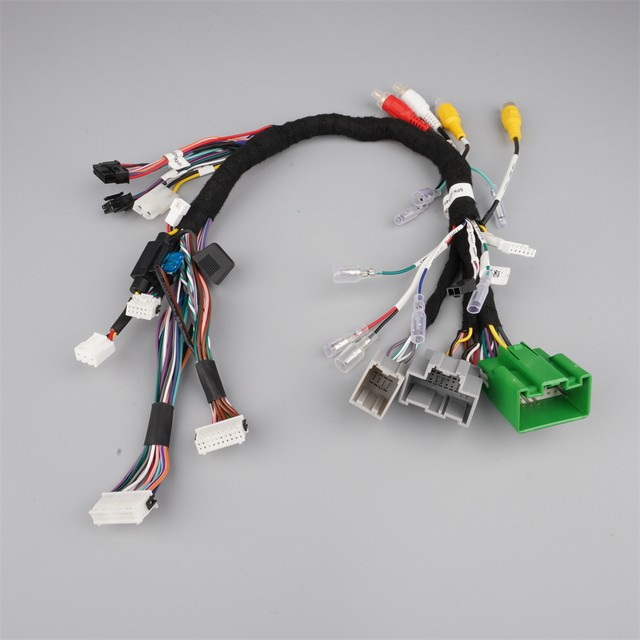
이 종합 가이드는 배선 하니스 내에서 개방되거나 단락된 전선을 식별하기 위한 자세한 단계별 프로세스를 제공합니다. 우리는 이해를 높이기 위해 데이터 분석과 제품 비교를 통합하여 필수 도구, 안전 예방 조치 및 진단 기술을 탐구합니다. 일반적인 과제를 해결하고 최신 트렌드를 통합함으로써 콘텐츠의 관련성과 실행 가능성을 보장합니다. 목록 형식과 표를 사용하여 추천 스니펫의 가시성을 높이고 Google 사용자 검색 의도에 직접 대응하는 것을 목표로 합니다. DIY 매니아이든 전문 기술자이든 이 가이드는 전기 문제를 효과적으로 해결하고 차량이나 장비의 전기 시스템의 신뢰성을 보장하는 지식을 제공합니다.
진단 과정을 시작하기 전에 배선 하네스가 무엇인지 이해하는 것이 중요합니다. 배선 하니스는 차량이나 전자 기기 내에서 전력과 신호를 전송하는 전선, 케이블, 커넥터의 조립체입니다. 이 하네스는 모든 구성 요소가 올바른 전압과 데이터를 수신하고 시스템의 기능과 안전성을 유지하도록 세심하게 설계되었습니다.
일반적인 배선 하니스는 다음을 포함한 여러 구성요소로 구성됩니다.
도체: 전류를 전달하는 전선입니다. 그들은 우수한 전도성으로 인해 일반적으로 구리로 만들어집니다.
절연: 도체를 물리적 손상으로부터 보호하고 단락을 방지합니다.
커넥터: 하네스의 여러 부분을 연결하고 다양한 전기 부품에 연결합니다.
타이 및 클램프: 하네스를 정리된 상태로 유지하고 손상을 일으킬 수 있는 이동을 방지합니다.
단선 또는 단락과 같은 문제는 종종 이러한 부품 내의 문제로 인해 발생하므로 이러한 구성 요소를 이해하는 것이 필수적입니다. 예를 들어 절연체가 손상되면 단락이 발생할 수 있고 도체가 파손되면 개방 회로가 발생할 수 있습니다.
배선 하니스의 전선이 열려 있거나 단락되었는지 확인하려면 몇 가지 필수 도구가 필요합니다. 올바른 도구를 사용하면 프로세스가 더 쉬워질 뿐만 아니라 정확성과 안전성도 보장됩니다. 필요한 도구 목록은 다음과 같습니다.
멀티미터: 이는 아마도 전기 문제를 진단하는 데 가장 중요한 도구일 것입니다. 멀티미터는 전압, 저항 및 연속성을 측정할 수 있으므로 개방 또는 단락된 전선을 식별하는 데 매우 중요합니다.
테스트 라이트: 테스트 라이트는 전압이 있는지 확인하는 데 도움이 되는 간단한 도구입니다. 이는 개방 회로를 식별하는 데 특히 유용합니다.
와이어 스트리퍼: 이 도구는 와이어에서 절연체를 제거하여 테스트용 연결을 만드는 데 사용됩니다.
드라이버 및 펜치: 배선 하니스에 접근하고 필요한 조정을 수행하는 데 필수적입니다.
전기 테이프 및 납땜 인두: 진단 중에 손상된 전선을 발견한 경우 임시 수리에 유용합니다.
시작하기 전에 이러한 도구를 준비하면 시간을 절약하고 철저한 진단을 수행할 수 있습니다. 또한 사고를 방지하려면 항상 도구의 상태가 양호하고 올바르게 사용하는지 확인하십시오.
적절한 예방 조치를 취하지 않으면 전기 시스템을 다루는 작업은 위험할 수 있습니다. 배선 하니스의 전선이 열려 있거나 단락되었는지 확인하기 전에 자신을 보호하고 시스템의 추가 손상을 방지하기 위해 몇 가지 안전 조치를 취하는 것이 중요합니다. 다음은 몇 가지 주요 안전 예방 조치입니다.
배터리 분리: 항상 배터리의 음극 단자를 분리하여 시작하십시오. 이렇게 하면 우발적인 단락을 방지하고 감전 위험을 줄일 수 있습니다.
보호 장비 착용: 감전 및 날아오는 잔해로부터 자신을 보호하기 위해 절연 장갑과 보안경을 사용하십시오.
조명이 밝은 곳에서 작업: 정확한 진단을 위해서는 좋은 조명이 필수적입니다. 전선과 연결부를 명확하게 볼 수 있어 실수할 가능성이 줄어듭니다.
젖은 상태에서 작업하지 마십시오. 습기로 인해 합선 및 감전이 발생할 수 있습니다. 작업 공간이 건조한지, 도구에 습기가 없는지 확인하십시오.
제조업체 지침을 따르십시오. 특정 지침 및 예방 조치는 항상 차량 또는 장비 설명서를 참조하십시오.
이러한 예방 조치를 취하면 안전하고 효율적으로 작업하여 사고 없이 문제를 진단하고 해결할 수 있습니다.
배선 하니스의 단선은 도체가 단선되어 전류가 흐르지 않는다는 의미입니다. 이로 인해 다양한 구성 요소가 오작동하거나 완전히 작동하지 않을 수 있습니다. 개방형 와이어를 확인하는 단계별 가이드는 다음과 같습니다.
먼저, 단선이 있는 것으로 의심되는 회로를 식별하십시오. 관련 전선 및 연결을 찾으려면 차량 또는 장비의 배선 다이어그램을 참조하십시오. 이 다이어그램은 전류의 경로를 이해하고 잠재적인 문제 영역을 식별하는 데 도움이 됩니다.
앞서 언급했듯이 안전을 위해 항상 배터리의 음극 단자를 분리하는 것부터 시작하십시오.
배선 하니스를 찾아 검사해야 하는 섹션에 액세스합니다. 여기에는 하네스에 접근하기 위해 패널이나 구성 요소를 제거하는 작업이 포함될 수 있습니다.
저항이나 연속성을 측정하도록 멀티미터를 설정하십시오. 이 설정은 와이어의 단선을 식별하는 데 도움이 됩니다.
테스트 중인 와이어 끝에 멀티미터의 프로브를 접촉시킵니다. 멀티미터에 무한 저항이 표시되거나 연속성이 없으면 단선을 나타냅니다.
열린 전선을 발견하면 하니스에 눈에 보이는 파손이나 손상이 있는지 주의 깊게 검사하십시오. 파손은 와이어 길이를 따라 어디에서나 발생할 수 있으므로 철저한 검사가 필요합니다.
파손된 부분을 찾으면 납땜과 전기 테이프를 사용하여 전선을 수리하거나 손상이 광범위한 경우 배선 하니스의 전체 섹션을 교체할 수 있습니다.
전선 단락은 두 전선의 절연이 손상되어 서로 접촉하여 의도하지 않은 전기 연결이 발생하는 경우 발생합니다. 이로 인해 퓨즈 끊어짐, 구성 요소 오작동 등 다양한 문제가 발생할 수 있습니다. 단락된 전선을 확인하는 방법은 다음과 같습니다.
다시 한번 단락이 발생한 것으로 의심되는 회로를 식별하는 것부터 시작하십시오. 배선 다이어그램을 사용하여 관련 전선과 연결을 찾으십시오.
안전 제일 - 배터리의 음극 단자를 분리하세요.
검사해야 하는 배선 하니스 섹션을 찾아 액세스합니다. 패널이나 구성 요소를 제거해야 할 수도 있습니다.
저항을 측정하도록 멀티미터를 설정하십시오. 이렇게 하면 전선 사이의 의도하지 않은 연결을 식별하는 데 도움이 됩니다.
멀티미터의 프로브를 하니스 내의 다른 전선에 접촉시킵니다. 연결하면 안 되는 두 전선 사이에 낮은 저항 판독값이 발견되면 이는 단락을 나타냅니다.
하네스에 손상된 절연체나 접촉된 전선이 있는지 주의 깊게 검사하십시오. 단락은 절연체 마모, 전선 뭉개짐 또는 기타 물리적 손상으로 인해 발생할 수 있습니다.
단락을 찾으면 손상된 절연체를 수리하거나 배선 하니스의 해당 부분을 교체하세요. 향후 문제를 방지하려면 모든 수리가 올바르게 수행되었는지 확인하십시오.
배선 하니스의 문제를 진단하는 것은 어려울 수 있으며, 특히 전기 시스템에 익숙하지 않은 경우 더욱 그렇습니다. 다음은 발생할 수 있는 몇 가지 일반적인 문제와 이를 극복하는 방법입니다.
배선 다이어그램은 특히 전기 시스템을 처음 접하는 사람들에게는 복잡하고 이해하기 어려울 수 있습니다. 이 문제를 극복하려면 시간을 내어 다이어그램을 주의 깊게 연구하세요. 색상으로 구분된 전선을 가이드로 사용하고 추가 도움이 필요한 경우 온라인 리소스나 포럼을 참조하세요.
배선 하니스의 손상이 즉시 눈에 띄지 않는 경우도 있습니다. 이를 극복하려면 철저한 검사를 수행하여 마모, 해어짐 또는 손상의 흔적이 없는지 확인하십시오. 손전등을 사용하여 좁은 공간을 살펴보고 와이어 추적 도구를 사용하여 숨겨진 틈을 찾는 것을 고려하십시오.
잘못된 도구를 사용하면 진단 과정이 어려워지고 잠재적으로 위험해질 수 있습니다. 앞서 나열된 대로 작업에 적합한 도구가 있는지 확인하십시오. 확실하지 않은 경우 전문적이거나 경험이 풍부한 기술자에게 문의하세요.
전기 시스템 작업에는 항상 위험이 따릅니다. 이러한 위험을 최소화하려면 항상 배터리 분리, 보호 장비 착용 등 안전 예방 조치를 따르십시오. 어떤 단계에서든 확실하지 않은 경우 전문가의 도움을 받으세요.
배선 하니스의 전선이 열려 있거나 단락되었는지 확인하는 것은 전기 시스템을 사용하는 모든 사람에게 중요한 기술입니다. 이 가이드에 설명된 단계를 수행하면 심각한 문제로 이어질 수 있는 문제를 식별하고 해결할 수 있습니다.
이 웹사이트는 귀하가 당사 웹사이트에서 최상의 경험을 할 수 있도록 쿠키를 사용합니다.
논평
(0)